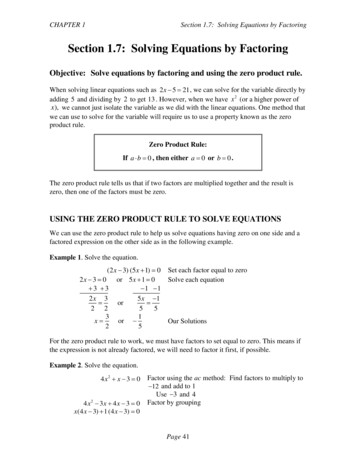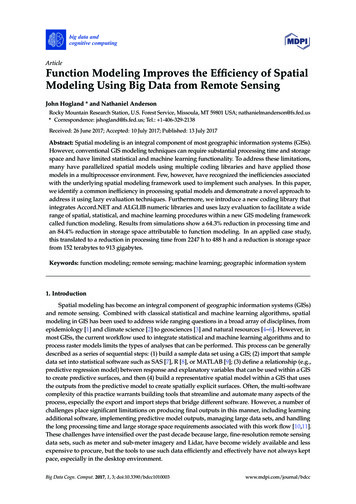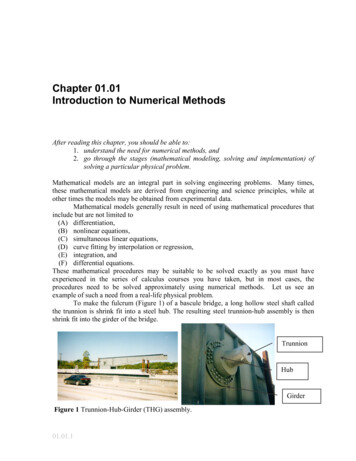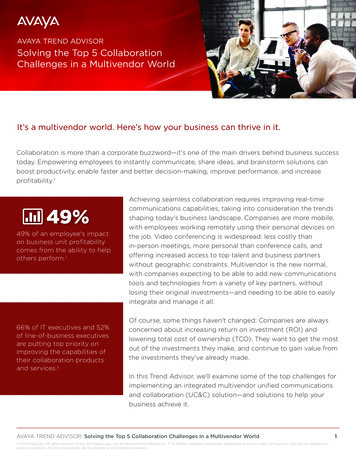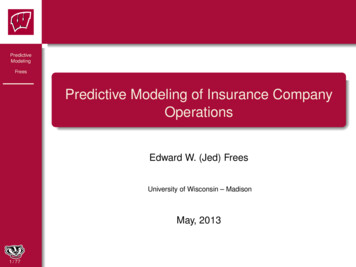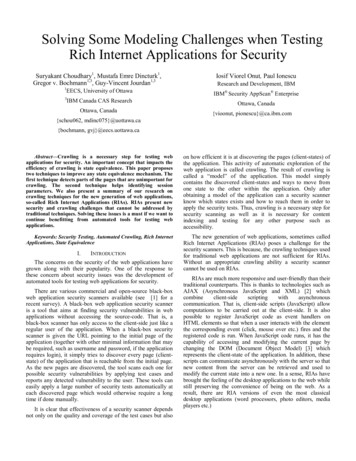
Transcription
Solving Some Modeling Challenges when TestingRich Internet Applications for SecuritySuryakant Choudhary1, Mustafa Emre Dincturk1,Gregor v. Bochmann1,3, Guy-Vincent Jourdan1,31EECS, University of Ottawa3IBM Canada CAS ResearchOttawa, CanadaIosif Viorel Onut, Paul IonescuResearch and Development, IBMIBM Security AppScan EnterpriseOttawa, Canada{vioonut, pionescu}@ca.ibm.com{schou062, mdinc075}@uottawa.ca{bochmann, gvj}@eecs.uottawa.caAbstract—Crawling is a necessary step for testing webapplications for security. An important concept that impacts theefficiency of crawling is state equivalence. This paper proposestwo techniques to improve any state equivalence mechanism. Thefirst technique detects parts of the pages that are unimportant forcrawling. The second technique helps identifying sessionparameters. We also present a summary of our research oncrawling techniques for the new generation of web applications,so-called Rich Internet Applications (RIAs). RIAs present newsecurity and crawling challenges that cannot be addressed bytraditional techniques. Solving these issues is a must if we want tocontinue benefitting from automated tools for testing webapplications.on how efficient it is at discovering the pages (client-states) ofthe application. This activity of automatic exploration of theweb application is called crawling. The result of crawling iscalled a “model” of the application. This model simplycontains the discovered client-states and ways to move fromone state to the other within the application. Only afterobtaining a model of the application can a security scannerknow which states exists and how to reach them in order toapply the security tests. Thus, crawling is a necessary step forsecurity scanning as well as it is necessary for contentindexing and testing for any other purpose such asaccessibility.Keywords: Security Testing, Automated Crawling, Rich InternetApplications, State EquivalenceThe new generation of web applications, sometimes calledRich Internet Applications (RIAs) poses a challenge for thesecurity scanners. This is because, the crawling techniques usedfor traditional web applications are not sufficient for RIAs.Without an appropriate crawling ability a security scannercannot be used on RIAs.I.INTRODUCTIONThe concerns on the security of the web applications havegrown along with their popularity. One of the response tothese concern about security issues was the development ofautomated tools for testing web applications for security.There are various commercial and open-source black-boxweb application security scanners available (see [1] for arecent survey). A black-box web application security scanneris a tool that aims at finding security vulnerabilities in webapplications without accessing the source-code. That is, ablack-box scanner has only access to the client-side just like aregular user of the application. When a black-box securityscanner is given the URL pointing to the initial page of theapplication (together with other minimal information that maybe required, such as username and password, if the applicationrequires login), it simply tries to discover every page (clientstate) of the application that is reachable from the initial page.As the new pages are discovered, the tool scans each one forpossible security vulnerabilities by applying test cases andreports any detected vulnerability to the user. These tools caneasily apply a large number of security tests automatically ateach discovered page which would otherwise require a longtime if done manually.It is clear that effectiveness of a security scanner dependsnot only on the quality and coverage of the test cases but alsoRIAs are much more responsive and user-friendly than theirtraditional counterparts. This is thanks to technologies such asAJAX (Asynchronous JavaScript and XML) [2] mmunication. That is, client-side scripts (JavaScript) allowcomputations to be carried out at the client-side. It is alsopossible to register JavaScript code as event handlers onHTML elements so that when a user interacts with the elementthe corresponding event (click, mouse over etc.) fires and theregistered code is run. When JavaScript code runs, it has thecapability of accessing and modifying the current page bychanging the DOM (Document Object Model) [3] whichrepresents the client-state of the application. In addition, thesescripts can communicate asynchronously with the server so thatnew content from the server can be retrieved and used tomodify the current state into a new one. In a sense, RIAs havebrought the feeling of the desktop applications to the web whilestill preserving the convenience of being on the web. As aresult, there are RIA versions of even the most classicaldesktop applications (word processors, photo editors, mediaplayers etc.)
Traditional crawling techniques are based on the fact that ina traditional application each page is identified by a URL. So,to crawl a traditional application it is enough to collect and visitthe URLs on the each page to discover the states of theapplication. But in RIAs, client-side scripts are able to changethe state on the client-side, which means that the URL does notnecessarily change when the state changes (many RIAs have asingle URL which points to the initial state). That means that inorder to crawl RIAs, a crawler needs to exercise event-basedexploration as well as the traditional URL-based exploration.Primarily motivated by the aim of making security scannersusable on RIAs, our research group has been working incollaboration with IBM to design efficient RIA crawlingtechniques. We have implemented some of the ideas of thisresearch in a prototype of IBM Security AppScan Enterprise[4], a security scanner for web applications.Previously we have presented in detail the requirements andanticipated problems for a solution to the RIA crawlingproblem as well as the shortcomings of the current attempts tosolve this problem [5]. Basically we require a RIA crawler to 1)produce a complete model in a deterministic way (it shouldcapture all the states and be able to produce the same modelwhen run multiple times on an unchanged website); 2) beefficient (discover as many states as possible in a given amountof time); 3) use an appropriate state equivalence relation (i.e. amechanism to identify the states that should be considered asthe same) depending on the purpose of the crawl and theapplication.We have also stated that satisfying these requirements maybe possible only when some limiting, but commonassumptions, are made about the application: 1) the applicationshould not have server-side states. That is, the global state ofthe application is only determined by the client-state. In thatcase we can expect that repeating an action on the same clientstate at different times will always result in the same state. 2)On a page where the user can enter a free text input in a form,using a finite set of representative input values is enough forcrawling purposes. This last assumption helps us not to missany state due to not entering a specific user-input value, sincein practice the result of an action might be different based-onthe user-input values.Some of the important anticipated problems were designingefficient strategies, choosing appropriate user-input values,deciding what to do if the application has some server-sidestates, how to choose an appropriate state equivalence relation,how to deal with the state explosion problem and how tofurther enhance the model for security.As a step forward in addressing some of these issues, in thispaper we focus on two important concepts that are importantfor efficient RIA crawling: state equivalence and crawlingstrategy. State equivalence is the mechanism used by thecrawler to decide whether or not two states should be regardedas the same. This is important since there are often situationswhere, although two pages reached by the crawler are notexactly the same, they are equivalent for the purpose ofcrawling. The simple example is an application that places anadvertisement in each page. For this application, visiting thesame page at different times will most likely result in pagesthat have different advertisements while everything elseremains the same. Although these two pages are not exactly thesame, a good state equivalence relation should detect andignore these “unimportant” parts. Failure to do so will likelyresult in infinite crawling runs or at least unnecessarily largestate spaces.A crawling strategy is an algorithm which decides whatactions to take next. For example, the crawling strategy decideswhich URL to follow next if it is doing traditional URL-basedexploration and in the case of event-based exploration (inRIAs), the crawling strategy decides from which state whichevent should be executed next.We have been working on the techniques to improve stateequivalence relations in addition to designing crawlingstrategies for event-based crawling of RIAs. In this paper, wepresent two techniques that help to improve the existing stateequivalence relations. Also we present a summary of ourresearch on crawling strategies.This paper is organized as follows. In Section 2, we presentthe techniques for improving any state equivalence relation.Section 3 contains a summary of our recent research oncrawling strategies for RIAs. Section 4 presents the relatedwork and Section 5 concludes with a summary ofcontributions.II.STATE EQUIVALENCEDuring crawling, the crawler navigates through the statesof the application by following the found links or executing anevent on the current state. When the crawler reaches a state, itmust know if it had already been to that state before.Otherwise, the crawler would regard each state as a new oneand it could never finish crawling and build a meaningfulmodel, it would just keep exploring the same states over andover again.The mechanism that is used by the crawler to decide if astate is equivalent to an already discovered one is called thestate equivalence relation. With a state equivalence relationthe crawler will recognize an already visited state and hence itwill not explore already explored events unnecessarily.Moreover, by identifying the current state it will know whereit currently is in the partial model constructed up to that point.Thus, the crawling strategy will be able to decide on its nextmoves based on that model (i.e. crawling strategy will knowwhether there is an already executed sequence of events thatwill lead from the current state to some other state).It seems very difficult to come up with a single solution forequivalence. The simplest equivalence relation is the equality.In this case, two states are considered equivalent only if theyare identical. But for most applications, this definition is toostrict and would lead to very large or infinite models. Clearly,deciding whether a given application state is “similar” toanother state very much depends on the application as well asthe purpose of the crawl. As an example, if the purpose ofcrawling is security scanning then the text content of the pageswould not be very important, hence could be ignored.However, from the content indexing and usability point ofview, the text content should not be ignored when deciding theequivalence of states. Being able to adapt the equivalence
relation to the application and the purpose of the crawl is thusvery valuable. For these reasons, we believe that stateequivalence should be considered independent of the crawlingstrategy.The choice of an appropriate equivalence relation shouldbe considered very carefully. If an equivalence evaluationmethod is too stringent (like equality), then it may result in toomany states being produced, essentially resulting in stateexplosion, long runs and in some cases infinite runs. On thecontrary, if the equivalence relation is too lax, we may end upwith client states that are merged together while, in reality,they are different, leading to an incomplete, simplified model.Although choosing a state equivalence relation requiresmany considerations, its correctness should not be put intonegotiation. That is, a state equivalence relation should be anequivalence relation in mathematical sense. Moreover, itseems reasonable to insist that equivalent states have the sameset of events, since otherwise two equivalent states would havedifferent ways to leave them.In the following, we present two novel ideas to helpimprove the efficiency of state equivalence of web applicationbeing crawled in an automated and efficient manner.A. Load, Reload: Discovering Unnecessary DynamicContent of Web Page.As mentioned above, Web pages often contain bits ofcontent that change very often but are not important in termsof making two states non-equivalent. When determiningwhether or not two states are equivalent, there is a desire to beable to ignore these constantly changing but irrelevant portionsof the page. This is important since failing to identify data thatshould be ignored could cause an equivalence function toevaluate to false when it otherwise would not.Thus one of the important challenges when defining stateequivalence functions is to exclude from the contentconsidered in the equivalence function the portion of thepage/DOM that may introduce false positives. The mostcommon current solution to the problem is to manuallyconfigure the crawler on a case by case basis, to make itignore certain types of objects that are known to change overtime, such as session ids and cookies. This is highlyinefficient, and is also inaccurate, since most of the time thislist is incomplete. Another solution is to use regularexpressions to identify in the DOM the portions of the contentthat can be ignored. The main problem with the latter solutionis the difficulty of creating the regular expressions and the factthat they are different for different sites. Automating thedetection of irrelevant page sections is desired since thosedifferences are also page-specific and as a consequence, theirrelevant parts vary from page to page even within the samewebsite.We have developed a technique for automatically inferringthe portions of the page that should be ignored. The techniquerequires loading a given web page twice. The DOM of thepage at each load can then be compared to see the differenceswhich indicate data that can be ignored. For example, a webpage X is loaded at time t1 and then again at time t2. The DOMof X at t1 is then compared to the DOM of X at t2 to produceDelta(X), in the form of a list of differences between theDOMs. When using an equivalence function to compare thisstate with another, the data in this list can be excluded.Therefore, two states can be considered equivalent if they areequivalent after the irrelevant data is excluded from both.Figure 1. DOM values for a web page X at two different time intervalsFigure 1 depicts a timeline with t1 and t2 being two distinctpoints in time. Assume that the crawler reaches and loads aweb page X at time t1 producing DOM(X) @t1. The same webpage X loaded at time t2 will produce DOM(X) @t2. LetDelta(X) represent the differences between DOM(X) @t1 andDOM(X) @t2. Delta(X) is the information that must beexcluded by the DOM equivalence function for web page X.This delta can be computed as a string difference between thetwo DOMs, or can be pictured as a collection of XPath values.Each of the XPath values will point to an element/location ofthe DOM that can be ignored. Furthermore, if an attributevalue is different between two DOMs, the XPath will point notonly to the node, but also to that attribute within the node thatis not consistent in time.The crawler will then record Delta(X) as being theirrelevant information to be excluded for any future DOMcomparisons for the web page X.Figure 2. Example of a page with irrelevant data which changes over timeLet us analyze a simple example of a page X that, afterrendering, contains the HTML document shown in Figure 2.As we can see, the webpage is displaying the current time, andlet us assume it displays one random sponsor at a time. LetDOM(X) @t1 be the document in Figure 2. Thus, it is feasibleto assume that a different request to the same server for pageX will return a different timestamp and a different sponsor.
Furthermore, let us assume that the second time when page Xis visited, the content will change as follows:Current time will be “1:45:31 pm” and the sponsor will be“http://mysite/aclk?sa l&ai Ba4&adurl http://www.mysite”We can now compute the Delta(X) as being the list ofdifferences as follows:Delta(X) {html\body\div\, html\body\a\@href}There are many ways to exclude Delta(X) from the DOM.For instance, each XPath that exists in the Delta(X) can besimply deleted from the DOM. Alternatively, every XPathfrom Delta(X) can be replaced with any of the t1 or t2 values.The idea behind is to have these two values equal after thecurrent step. This will make the DOM comparison algorithmto see all the XPath in the Delta(X) as having the same values,and therefore not different. Finally, another technique will beto replace each XPath with a constant. This action, like in theearlier case, will make the DOM comparison algorithm see nodifference in the values of these XPaths. Regardless of themethod used to exclude the Delta(X) from the DOM, thisprocess will be transparent to the DOM comparison algorithm.As a result, two new DOMs t1' and t2' are produced.These two new DOMs can now be sent to the comparisonalgorithm. The state diagram in Figure 3 shows how ourproposed algorithm applies to the crawling paradigm ingeneral.In addition, when computing Delta(X), to further increasethe differences between two consecutive loads, the crawlercould redirect one of the two requests through a proxy.Practice shows that web pages may display different contentbased on the origin of the request, for instance users fromdifferent countries or even provinces may see differentadvertisements when visiting the same web page. Thus far, theproposed algorithm keeps track of the Delta(X) and excludes itfrom the DOM comparison method.Alternatively, one could keep track of the parts in theDOM that do not change in time and consider only those forthe DOM comparison method. Those common parts of theDOM would in this case act like a mask to the current DOM.Regardless of the technique, the effect will be the same (i.e.the Delta(X) will be excluded from the data sent to the DOMcomparison function).A simple experiment of the technique conducted on 30popular websites (see Appendix for the list) show that only 4out of 30 (13%) did not change their content on twoconsecutive loads (the time between the consecutive loads is10 seconds) [15]. The differences in the 26 other sites provedto be advertisements links, usage statistics, or timestamps thatmust be ignored by crawlers. Failure to do so may lead to thecreation of a large or even infinite number of states, since thestate equivalence method will likely separate the states basedon these differences.Figure 3. Integration design between a DOM comparison method and theproposed techniqueB. Identifying Session Variables and ParametersWeb sites usually track users as they download differentpages on the web site. User tracking is useful for identifyinguser behavior, such as identifying purchasing behavior bytracking the user through various page requests on a shoppingoriented website. Since HTTP is stateless, most modernserver-side technologies keep the state information on theserver and pass only an identifier between the browser and theserver. This is called session tracking. All requests from abrowser that contain the same identifier (session id) belong tothe same session and the server keeps track of all informationassociated with the session. A session id can be sent betweenthe server and the browser in one of three ways:1) As a cookie2) Embedded as hidden fields in an HTML form3) Encoded in the URLs in the response body, typicallyas links to other pages (also known as URLrewriting)Among the three methods, using cookies is the mostcommon. Although URL-rewriting is not the most common,many web application servers offer built-in functionality, toallow the application to run with browser clients that do notaccept cookies. The method of URL-rewriting works asfollows. When the user requests a page of a web site with aURL that does not have a session identifier, a sessionidentifier is created for this user and the user receives aversion of the entry web page in which links on the page areannotated by the session identifier. That is, each URL in theresponse page contains the created session identifier which isusually a string of random characters. When the user selects alink, the web server parses the session identifier from theURL, attaches the same session identifier to the local links onthe next generated web page, and returns that web page to theuser. The web server continues to parse and attach the sessionidentifiers as long as the user requests a page who’s URL has asession identifier.As an example of the difficulties caused by not detectingthe session identifiers, consider the situation of a web crawler
which has found multiple URLs without session identifiersand pointing to pages in the same website. Let’s for the sakeof simplicity assume that there are two such URLs, calledURL1 and URL2. A typical crawler will collect URL1 andURL2 and put them in its queue to process. If the serverhosting the website pointed by URL1 and URL2 is using URLrewriting, when the crawler requests URL1 the server willnotice that URL1 does not contain a session identifier, so theserver will produce a session identifier and will return a pagewhere all URL’s contain the generated session identifier.When the crawler requests URL2, the server again will noticeURL2 does not have a session identifier and generate a sessionidentifier, most probably different from the first one that isproduced when URL1 was requested. Thus two sessions havebeen created for the crawler. It is very likely that the crawlercan find in two different sessions URLs that are pointing to thesame page within website. However, since those URLs arefound in different sessions, the crawler will not be able tounderstand that they are actually the same URLs except fordifferent session identifiers. The crawler would thus crawl thesame web pages redundantly, thus wasting the crawler's timeand bandwidth (and if the crawling purpose was contentindexing, filling the search engine's index with duplicatepages, thus wasting storage space).Another problem faced by automated crawlers, not beingable to detect session identifiers is session termination. If theclient fails to provide the correct session identifiers, the webapplication will terminate the session and the crawl operationwill result in poor application coverage.The current solutions for these problems are not reliable.They are based on heuristics, such as known session id namepatterns or entropy of the values. There are two sources ofweakness with the current solutions: 1) they rely on expertknowledge to create; 2) they depend on common practices thatservers use to populate these values. That is, the currentsolutions require human intervention (not automated) andcannot be effective in case of a server that does not use one ofthe common practices.One fundamental point about the session identifiers is thatthey are by definition unique for a session. This applies to anyrequest component regardless of the place or time when it isconstructed. There is also the case where a session id willmaintain the same value for subsequent sessions, but willexpire after a period of time (session timeout). In this case thealgorithm we propose can be reapplied after the session hasexpired and the session id can be identified this way.Based on these considerations, we propose a techniquewhich compares all the request components recorded duringtwo different login sequences. As a result of this comparison,any variable that changes its value between these two differentlogin sequences is flagged as a session identifier used by thecrawling engine. Conversely, any variable that has the samevalue in two recorded sequences will not be considered asbeing part of the session identifiers set.The proposed algorithm requires that the two recordings ofthe log-in sequence are done on the same website, using thesame user input (e.g. same user name and password) and thesame user actions. Failure to respect this requirement will leadto invalid results.It is also important that the session is invalidated betweenthe two recording actions or that the second recording actionwill occur when the crawling has reached an out-of-sessionstate.Let’s take for example the following two recorded loginsequences. The entities in the square brackets are parameters,passed as part of the POST request to the server such as username, password etc.1) Sequence 11.1 Request 1GET https://www.site.com/bank/login.php HTTP/1.1Cookie: PHPSESSIONID c9bqcp9w97qgfq4w;1.2 Request 2For example in the case of URL-rewriting sessionidentifiers the relevant value will be passed in the request ank/login.phpHTTP/1.1GET /S(120fd4ovfqyogf34f)/home.aspCookie: PHPSESSIONID lternatively, some web application developers mayimplement their own version of the mechanism. In order tohandle such a case the web crawler has to be preconfigured toidentify the session id value. Since such combinations are leftto the creativity of web application developers, it is almostimpossible to maintain a reliable set of heuristics in order toidentify URL-rewriting session identifiers.Thus, there is a need to effectively identify web sites thatcontain session identifiers and to be able to identify all theparameters and cookies that need to be tracked by the crawlingengine in order to improve web crawling and successfullyperform the scan. Unless prior knowledge of this fact is givento a crawler, it would find an essentially unbounded number ofURLs to crawl at this one web page alone.1.3 Request ain.phpHTTP/1.1Cookie: PHPSESSIONID c9bqcp9w97qgfq4w;2) Sequence 22.1 Request 1GET https://www.site.com/bank/login.php HTTP/1.1Cookie: PHPSESSIONID caksvkOACSCACC00d2kkqbd;2.2 Request 2
gin.phpHTTP/1.1discover new states using fewer event executions and resets ismore efficient, since the event execution and resets are theoperations that dominate the crawling time.Cookie: PHPSESSIONID caksvkOACSCACC00d2kkqbd;The existing tools for crawling RIAs [8] [9] [10] use one ofthe two basic crawling strategies that are Breadth-First (BF)and Depth-First (DF) search. Although BF and DF are capableof exploring an application completely, they are not veryefficient in most of the cases. One reason is that BF and DF arevery strict exploration strategies. For example, DF does notexplore any other state further unless the most recentlyexplored state is completely explored. Consider the case wherewe execute an event of the most recently discovered state andwe end up at a state that was previously discovered. In this caseDF will go back to the most recently discovered state althoughthe current state (or some state that is much closer to thecurrent state than the most recently discovered state) may stillhave unexplored events. Making such strict decisions definitelyincreases the number of events executed by any crawler thatuses a DF strategy. (Similar inefficiencies occur with BF wherethe least recently discovered state is given strict explorationpriority). In addition, DF and BF crawling does not make anyprediction about the application behavior. In fact, it is possibleto increase the efficiency of the crawling if accurate predictionscan be made about the application behavior. These predictionsmay be based on the partial but valuable information collectedduring crawling. For example, by looking at previousexecutions of an event (in different states), it might be possibleto predict how that event is likely to behave in a state where ithas not yet been executed. Or predictions can even be madebefore even crawling begins by observing some generalbehavioral patterns in the given RIA. Later these patterns canbe used as a guide for the crawling strategy. With thesemotivations, we have been investigating crawling strategiesdifferent from BF and jsmith],[password]:[Demo1234]2.3 Request in.phpHTTP/1.1Cookie: PHPSESSIONID caksvkOACSCACC00d2kkqbd;Looking at the differences between these two log-insessions we notice that the value that precedes the /bank pathelement is dynamically generated. In addition the value of thePHPSESSIONID cookie also changes between the two logins.Out of all the parameters, we notice that the value of thesession-id parameter changes while the username andpassword remain the same.In this technique, the following operations are performedafter two login sequences have been recorded:1) Separate all elements of the request. For example pathelements will be separated using predefined pathdelimiters. The same goes for parameter values which willbe separated by body delimiters. It is important to identifythe delimiters because two values of the same session idmight contain a common substring across different logins.2) Compare the two sequences and identify the elements thatchange.3) Construct session identifier entities that can be handledaccordingly by the crawlerAs discussed above, web sites that use session identifiersmay be automatically identified by comparing in-host links tomultiple copies of documents from the web sites. Knowingthat a particular web site uses session identifiers andidentify
collaboration with IBM to design efficient RIA crawling techniques. We have implemented some of the ideas of this research in a prototype of IBM Security AppScan Enterprise [4], a security scanner for web applications. Previously we have presented in detail the requirements and anticipated problems for a solution to the RIA crawling




